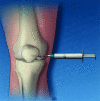Musculoskeletal injection
- PMID: 19720781
- PMCID: PMC2735433
- DOI: 10.4065/84.9.831
Musculoskeletal injection
Abstract
Patients commonly present to primary care physicians with musculoskeletal symptoms. Clinicians certified in internal medicine must be knowledgeable about the diagnosis and management of musculoskeletal diseases, yet they often receive inadequate postgraduate training on this topic. The musculoskeletal problems most frequently encountered in our busy injection practice involve, in decreasing order, the knees, trochanteric bursae, and glenohumeral joints. This article reviews the clinical presentations of these problems. It also discusses musculoskeletal injections for these problems in terms of medications, indications, injection technique, and supporting evidence from the literature. Experience with joint injection and the pharmacological principles described in this article should allow primary care physicians to become comfortable and proficient with musculoskeletal injections.
Figures



References
-
- Stafford RS, Saglam D, Causino N, et al. Trends in adult visits to primary care physicians in the United States. Arch Fam Med. 1999;8(1):26-32 - PubMed
-
- Wigton RS, Alguire P. The declining number and variety of procedures done by general internists: a resurvey of members of the American College of Physicians. Ann Intern Med. 2007;146(5):355-360 - PubMed
-
- Cuccurullo S, Brown D, Petagna AM, Platt H, Strax TE. Musculoskeletal injection skills competency in physical medicine and rehabilitation residents: a method for development and assessment. Am J Phys Med Rehabil. 2004;83(6):479-485 - PubMed
Publication types
MeSH terms
Substances
LinkOut - more resources
Full Text Sources

